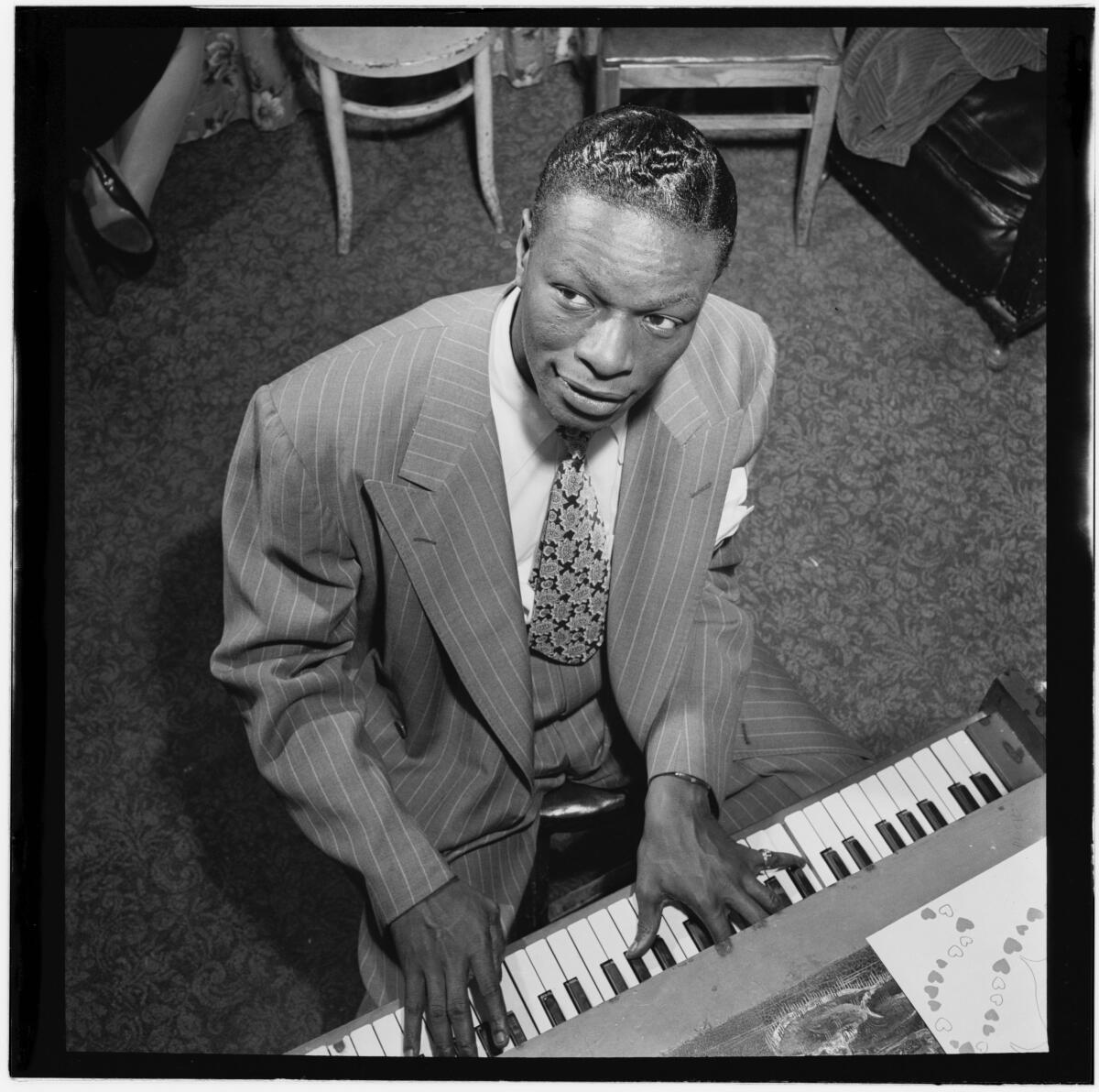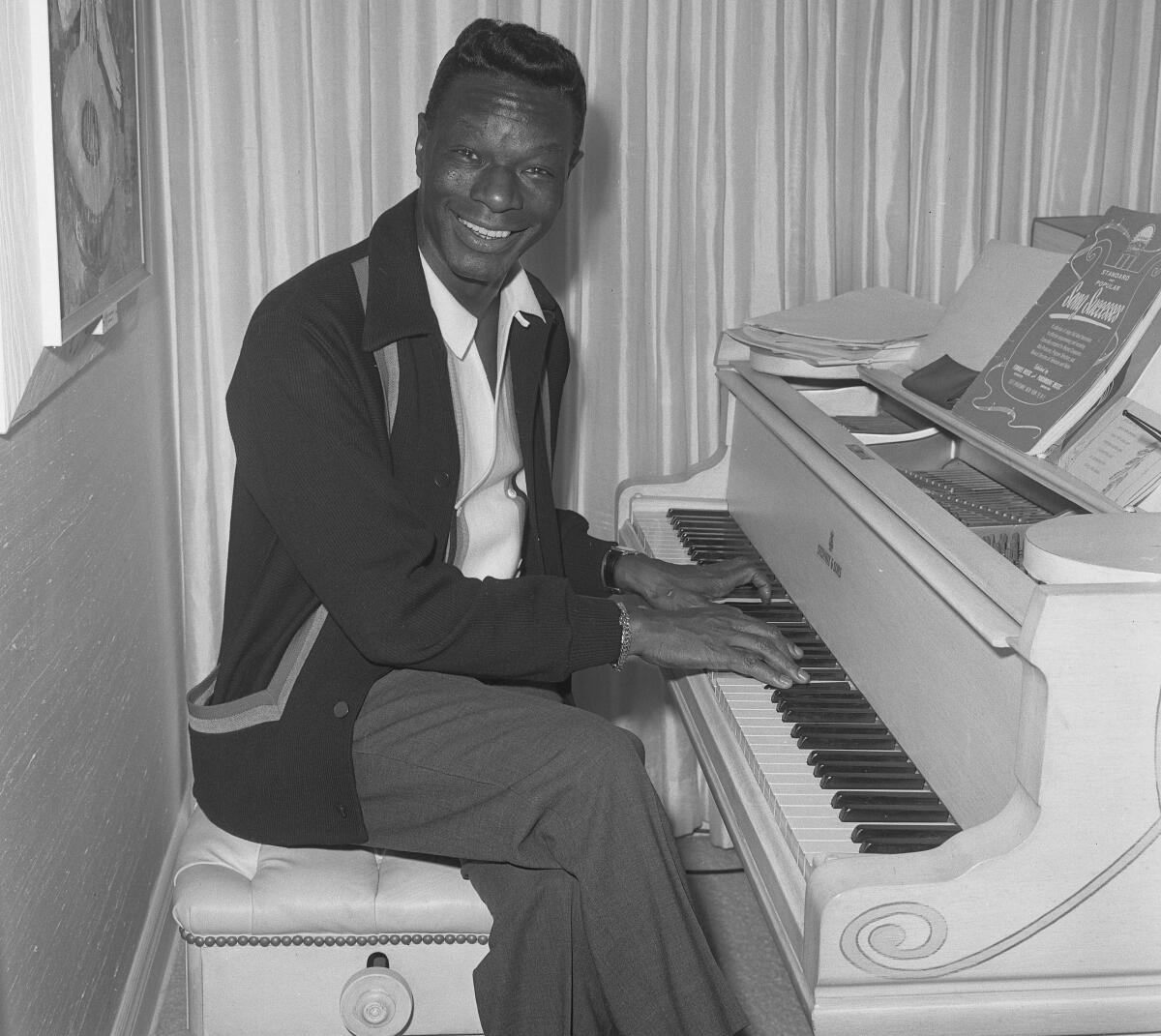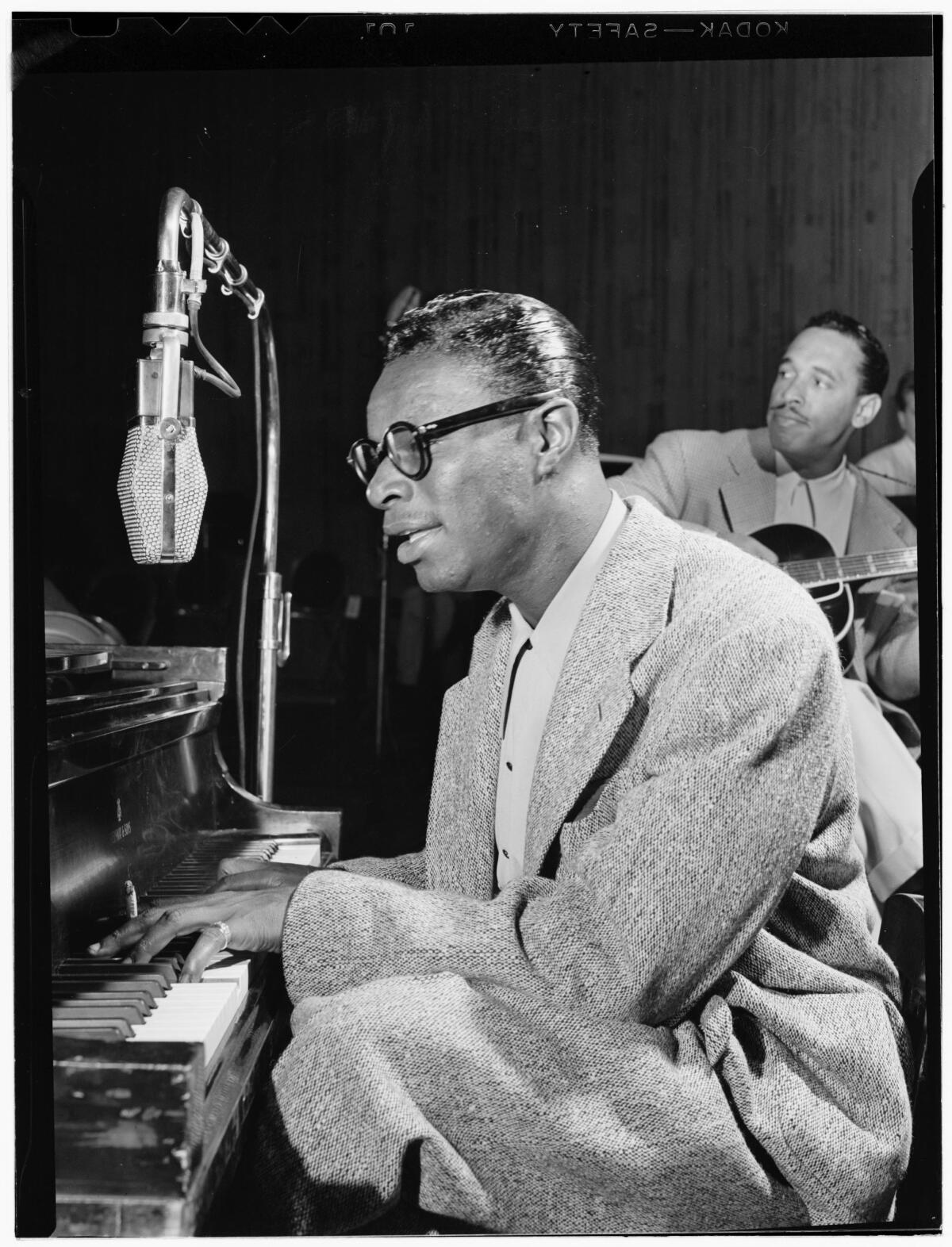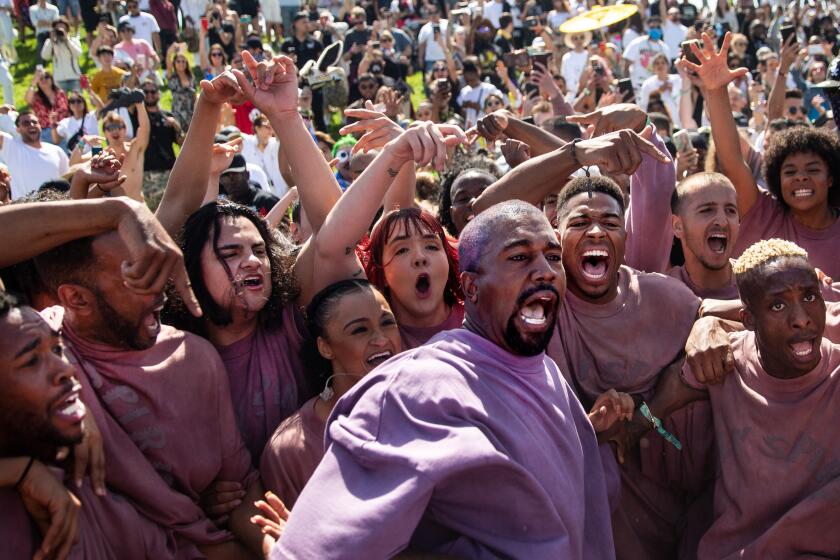Irving Azoff’s Iconic Artists Group buys rights to Nat ‘King’ Cole assets

- Share via
Twin sisters Casey and Timolin Cole were born into a life of unusual luxury in Hancock Park to a father nicknamed “King” whose success was so great that the historic Capitol Records building not far away in Hollywood was nicknamed “The House That Nat Built.”
Caretakers of legendary singer-bandleader-pianist Nat “King” Cole’s legacy and estate through their King Cole Productions, for decades they have helped maintain and advance their dad’s uniquely American story. It’s one that began with his youth as a precocious Chicago teenage jazz pianist and ended, in 1965, with his death from lung cancer at age 45, an icon whose crossover success and remarkable musicality changed 20th century American culture.
On Friday, Iconic Artists Group, the legacy management firm owned by music executive Irving Azoff, announced that it had entered into a long-term agreement with Cole’s daughters to administer, protect and further expand Nat “King” Cole’s music, style and brand.
“What’s that song, ‘To everything there is a season’? We thought that the time was right,” says Timolin Cole on the phone from South Florida, where both she and her sister live.

The deal encompasses a broad range of rights including Cole’s recorded music, publishing, television show, name and likeness. It comes during a moment when artists including Bob Dylan, Neil Diamond, Leonard Cohen and Bruce Springsteen have sold their catalogs and various rights for hundreds of millions of dollars. Terms of the deal were not disclosed.
In a statement to The Times, Azoff said, “Nat King Cole is an American icon in every sense of the word. His contribution to music, style, dignity, is both unique and timeless. We are honored to have the opportunity to preserve his legacy going forward.”
Ye’s discography and celebrity mean he can still headline mega music festivals. But his latest outbursts and threats may be too much for fans to bear.
Iconic will build on a foundation that the twins, their late siblings Natalie Cole, Nat Kelly Cole and Carole Cole and others have maintained since the patriarch’s death. Cole had by then sold millions of records for the once-fledgling Capitol Records and become the first Black artist to host his own network TV show. In many American households, the holiday season for many decades wasn’t complete without Cole’s take on “Christmas Song” and his album “The Magic of Christmas.”
Possessor of a velveteen baritone, perfect pitch and brilliant piano skills, Cole is known for his recordings of songs including “Unforgettable,” “Mona Lisa” and “Rambling Rose.” He sold his first song, “Straighten Up and Fly Right,” in 1937 for $50, according to the Songwriters Hall of Fame, but across his career had more success as an interpreter.

Success, though, is an understatement. Friends with Presidents John F. Kennedy and Lyndon B. Johnson, Cole charted 86 singles and 17 albums in the top 40 between 1943 and 1964, according to the Rock and Roll Hall of Fame, into which Cole was inducted in 2000. Remarkably versatile, Cole effortlessly connected genres including jazz balladry, piano-driven instrumental jazz, Latin-language songs and mainstream pop. After signing with Capitol in the mid-1940s, Cole recorded hundreds of singles, the sales of which allowed the label, then located in a shared space at Sunset and Vine, to hire architect Louis Naidorf to design the landmark stand-alone building down the block.
At his peak, Cole was one of the most sought-after interpreters in America, collaborating with marquee arrangers including Nelson Riddle, Gordon Jenkins and Billy May and competing on the pop charts alongside Frank Sinatra, Perry Como, Brenda Lee and others.
At Cole’s funeral, honorary pallbearers included Robert F. Kennedy, Count Basie, Sinatra and then-California Gov. Pat Brown. By then, the American public had been following Cole’s cancer diagnosis for months. The Times reported at the time that “a half a million intimates and fans [had] sent Cole sympathetic messages after he entered the hospital.”
“We look for artists who’ve had a cultural impact, and Nat ‘King’ Cole definitely did,” says Jimmy Edwards, president of Iconic Artists Group. “Everybody knows a Nat ‘King’ Cole song.” Cole is the first non-living addition to Iconic’s roster, which includes Linda Ronstadt, David Crosby and the Beach Boys.

“The analysis of a person’s career doesn’t end with their death,” says Grammy-winning jazz vocalist Gregory Porter, who in 2017 released the “Nat King Cole & Me” tribute album. “You apply the importance of their music to whatever time we are in, and in that respect Nat’s music is timeless.”
As with any Black artist of the period, Cole’s story involves a career spent enduring racism. In 1948, he and his second wife Maria Hawkins bought a home from a friend in Hancock Park despite it being in a whites-only neighborhood.
“This is not an act of defiance,” Cole told The Times in August 1948 in a story with the deceptively benign headline, “Hancock Home Purchase Stirs Quandary.” The article described the sale as being made “through a ‘dummy’ Caucasian purchaser.”
“My bride and I like this house. I can afford it. And we would like to make it our home,” he told The Times. Adding that he had “always been a good citizen,” Cole concluded with an invitation: “I would like to meet all my new neighbors face to face and explain these things to them.”
Though shunned at first and threatened by Ku Klux Klan members who burned a cross on the Coles’ lawn, the family remained in the house until his death.
“Any successful person tries to insulate themselves from the trials and tribulations of life once you reach a certain level,” Porter says. “But that was an impossibility for him with the racial difficulty in our country — even in him purchasing a house and being attacked on stage.”
Multiplatinum singer Johnny Mathis used to visit Cole at the Hancock Park house he shared with his wife and five kids, and was very aware of the threats and hate.
“We spoke about it later on in life after we became friends,” says Mathis, now 86. “I was so proud of him, because no one that I ever met in the business was as polite and as loving and gentlemanly as Nat. For anybody to deny him living in the neighborhood, of course, was ridiculous.”

Despite the hate and resistance, Cole soared through the 1950s releasing hit records both alone and with his Nat “King” Cole Trio while earning millions for both himself and Capitol. In the decades since his death, Cole’s voice and spirit have continued to permeate culture. His recordings have appeared in movies including “Raging Bull,” “Groundhog Day” and “In the Mood for Love” and TV series including “Ted Lasso,” “Breaking Bad” and “The Sopranos.”
Mathis says that despite Cole’s success as a singer and recording artist, his talent was multifaceted, something Mathis learned at an early age. While growing up in San Francisco, he and his music-loving dad would often go to clubs to see Cole perform, an experience that continued as Mathis was commencing his own artistic journey. “I was always in these big cities. Wherever he was, I would go and hear him and watch him sing. Not only did he have a beautiful, loving voice, but most people don’t realize that he was a fabulous, fabulous musician.”
Porter says that Cole used those gifts to break barriers. “Nat’s approach was, ‘Let me get in the house. Let them see.’ He was trying to beat down walls with his genius — a Black man in hundreds of thousands of peoples’ living rooms singing songs of love and compassion while dressed impeccably.”
Porter adds, “He had a profound effect on how people visualized a Black man at the time.”

Cole’s experiences with racism have been widely chronicled, but other periods of his life are less appreciated, says Iconic’s Edwards, a former executive with the Warner Music Group and Frank Sinatra Enterprises. That’s especially true of Cole’s brilliance leading his jazz trio. As such, these stories are ripe for exploration, whether through documentaries, scripted TV series or biopics. “Stories are always the most important thing,” he says.
He cites as an example Cole’s “days in Chicago when he would go up against [pianist] Earl Hines as a 16-year-old kid and he was the talk of the town. He was outside the clubs listening to Louis Armstrong.” Edwards calls the period in Cole’s life as possessing “a whole cool element of Chicago that I don’t feel it has been explored. That’s an unbelievable story that has gangsters and the greatest jazz musicians involved.”
In addition to the Capitol Tower, Cole’s voice left his mark on the entertainment business in another revolutionary way when his daughter Natalie recorded a Grammy-winning duet with her father — a quarter-century after his death. “Unforgettable” had already been a hit decades prior when, using multitrack technology, Nat joined Natalie in 1991 for a posthumous session. The album that followed, “Unforgettable ... With Love,” went on to sell more than 7 million copies. The album and songs from it earned six Grammy trophies including record of the year, song of the year and album of the year. At the time considered a novelty, such beyond-the-grave collaborations now regularly appear on the pop charts. (Natalie Cole died in 2015.)
Cole is not yet slated to duet with Adele or be featured in any new metaverse projects, but Edwards says that nothing’s off the table, including a Nat “King” Cole line of apparel. “He was such an unbelievable style icon — so elegant but cool and relaxed.”
He adds: “What we like to do is get in there with the archives and give the full picture, tell the full story. Nat gave us the ability to do that.”
More to Read
The biggest entertainment stories
Get our big stories about Hollywood, film, television, music, arts, culture and more right in your inbox as soon as they publish.
You may occasionally receive promotional content from the Los Angeles Times.












